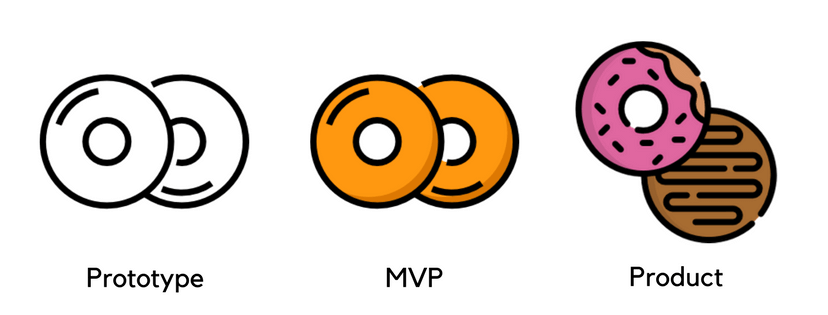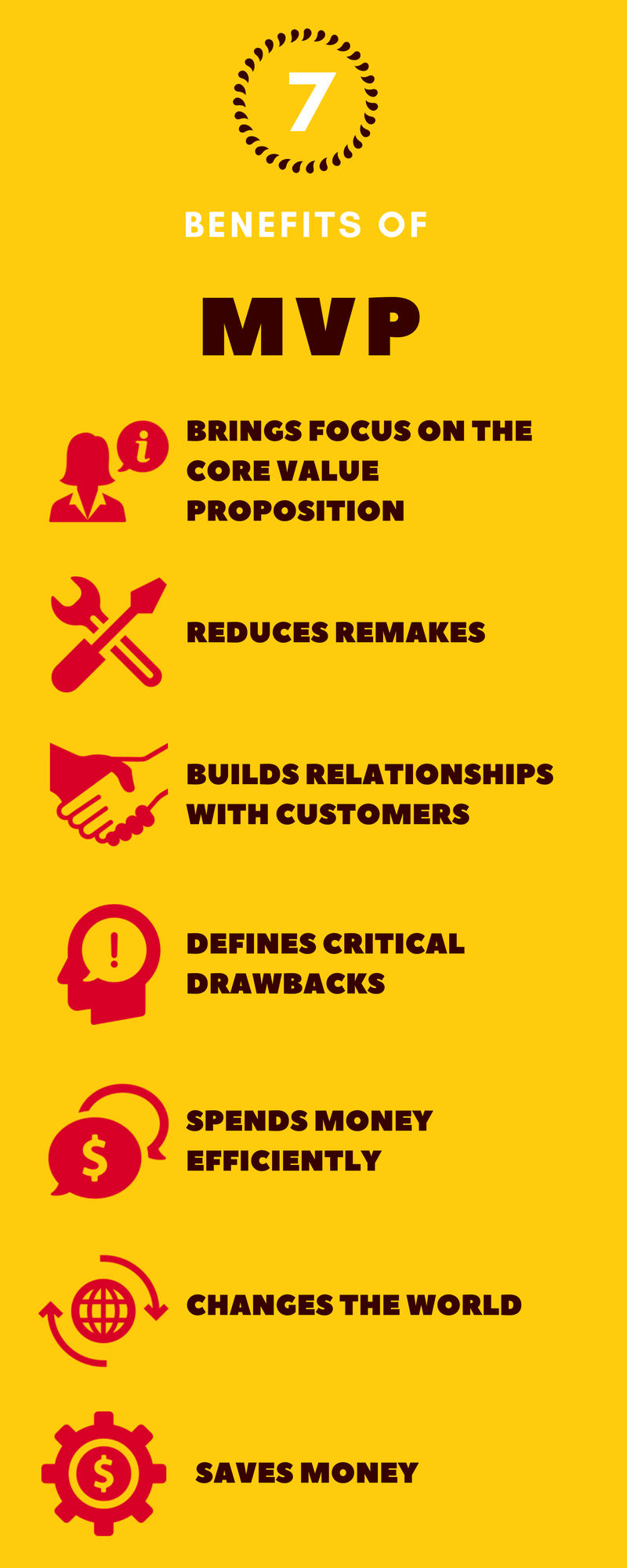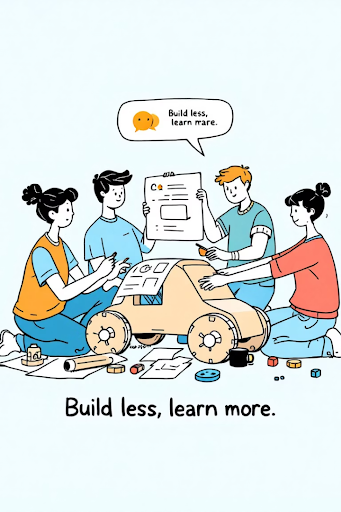MVP meaning
Circumstances might be different for you, but you see, time goes against you. When someone has already gained success, you’re just thinking about it. But no matter where you are now is the perfect time to launch a product. Why? First, you are eager to roll the dice while you're reading this. Second, that has probably been on your bucket list for years. It’s time!
If you’re at that point when there is just an idea and nothing has been built yet, your only goal should be to prove the product you want to build solves a problem.
It may seem easy, but when it comes to reality, many products are built that don’t actually solve a problem for anyone. It may look brilliant, have lots of features, but at the same time be absolutely useless. How often have you encountered such situations? What? Never?

How about wearing the Shoe Umbrella? Would you like to go somewhere with two umbrellas attached to your shoes, even if your shoes are very elegant? How funny is that!
Build a product that solves a problem.
The first version of a product is often called Minimum Viable Product (MVP). You ask, what is MVP? Well, it is the product that has only the core features that make the product work. The simplest example is on the picture.

Many talented people made an impact on an MVP concept. But the most famous was the author of the Lean Startup methodology Eric Ries. He as:
A Minimum Viable Product is that version of a new product which allows a team to collect the maximum amount of validated learning about customers with the least effort.
In general, the purpose of this product is to test the demand. The market reaction defines whether you are inspired to expand your business or just stop.
What does MVP stand for
MVP stands for a minimum viable product, not a minimum viable prototype. As prototype serving a narrow purpose is not a product. There might be lots of similar prototypes to one product.
On the contrary, a minimum viable product is a real product and people are gonna use it and pay for it. MVP needs to have a clear goal and a set of features to promote this main feature.
Benefits of MVP
Over years of building MVP for our business partners, we realized that most of them have a distorted image of a minimum viable product. They mostly tend to overbuild the first release of a product. Their goal is to simply to differentiate themselves from the competition. But this just takes more time that could be spent on exploring the user’s reaction and improving the product. So with an MVP, we increase the product’s success chances. Here’s what it actually gives:

1 Brings focus on the core value proposition
With MVP you have to define your value proposition clearly and narrowly. That gives you an opportunity to define goals, needed functionality, and spend time and money efficiently.
2 Reduces remakes
Extra features may only complicate user experience. Keeping it simple will guarantee minimum remakes of the product features.
3 Builds relationships with customers
First users may provide you the needed feedback on the desired changes or additions. This will improve your product and might create a community of users.
4 Defines critical drawbacks
It allows to find weaknesses fast and improve it. It will ensure that all the functions work properly before going further.
5 Spends money efficiently
As the product development cycles are iterative, there is no need to search for a huge amount of money at once. Over time you can invest your own money if at first, you used someone else’s money.
6 Changes the world
Only new ideas qualify as MVP, so it requires to make a difference towards what was before.
7 Saves money
In the end, if your idea is proven to be a failure at least you haven’t spent a lot of money!
How to Build an MVP for your Startup
First, decide whether you need to build an MVP. If you already have an audience and this product is another way to expand your business, then you might not need it. Typically, building MVP is a measure when you want to ensure the solution is viable without spending a lot of money. It serves as a handy proof of concept, but if you know for sure it will sell, that’s proof enough!
In other cases, just do the following.

1 Preparation process
That’s where you brainstorm your ideas and when it’s chosen you check its chances to become successful. That’s the stage where you put your idea into documentation and define what your product actually does. This can involve pinpointing the problem your MVP will solve, such as an inefficient supply chain or a lack of functionality in off-the-shelf software. Then, you assess how many potential clients actually have that problem and want a new solution.
Your whole business model shouldn’t hinge on guesswork, so this stage is about taking hard data to analyze your course of action. Proper preparation will ensure you’re making a piece of software that’s useful to a specific niche and help you limit spending on development.
2 Hiring developers
Developing a minimum viable product requires experience. If you decided to go on this path, then it is time to hire a professional development team. While some companies may have in-house staff to do the work, a startup will almost certainly need outside help. It is better to start smart and go with the skilled ones—well, once again saves time and money!
3 Designing the prototype
Here’s where the real thing begins. It is a step closer to the MVP. Excited? Here you need to be proactive before the testing phase begins. Once it's built, you have something to be tested, reviewed, and analyzed. The design stage should also include the MSCW method, which allows you to determine what your minimal viable product needs - must, should, and could have. The “won’t have” ones are, of course, unnecessary, at least at this stage.
4 Building MVP
This is the stage where you actually finish your MVP when you have gone through some first users experience and lots of experimentations. Take careful note of their feedback, asking leading questions to determine what feature they value most and what feels extraneous. Plus, track analytical data to see which aspects of the product deliver on their value proposition. If everything goes well and the clients are happy, the full solution should be successful. Finally, it is ready for the market. What a relief!
There is a but, as the next stage will define your product’s the whole future. Take a breath and go get your success!
What are Some Practical Tips for Identifying MVP Features?

As we pointed out above, the first step in building MVP features is preparation, and you need to use things like the MSCW method to determine what your MVP needs. We also recommend user mapping, putting yourself in the mind of the client, and building an effort/impact matrix. The latter lets you determine which functionality has the highest value proposition with the minimal cost.
It’s also a good idea to keep the scope of your minimal viable product realistic, as some companies prefer to limit the development and validation of each feature to just a week. This keeps the pace of development rapid. Another way to speed things up without compromising quality is to use AI.
For example, an AI system like Jasper can validate your business model by analyzing the market and client interests to confirm you’re on the right track. It’s also useful in iterating on design elements with quick version changes, which you can do with Figma AI. Plus, your developers can use code generators like Github Copilot to quickly cover standard parts of the work as they focus on manually writing the more complex parts.
Your MVP development should be like a startup - lean, fast, and with a clear goal. This makes lightweight tech such as React or Next.js an obvious choice for the solution. So when you’re picking features, consider how these can be used and prioritize efficiency.
Conclusion
What you need to do now is commit your future several months to create the minimum viable product. By the way, we’ll be happy to lend a helping hand, as we already did it before.
Don’t let your valuable time pass by without acting on your dream!
Freaquently Asked Questions
What makes MSCW good for building MVP features?
It lets you focus on what truly matters – feature viability and value. You’re not looking at hyped-up trends, but rather zeroing in on client needs and selecting features based on that.
When is MVP not necessary?
You typically don’t need a minimal viable product if you’ve already launched a good array of offerings that have succeeded in the market. This means you have a reputation and some built-in clientele, letting you bank a little more on your chance of success. In such a case, you can skip the MVP stage if you want to, as long as it’s in line with your business model.
Is outsourcing MVP development always beneficial?
As mentioned in the guide above, a small startup typically lacks the internal resources to create its own MVP, making outsourcing essential. But a big enterprise could probably do it themselves, though an outsource team would do it cheaper and, potentially, faster.
What makes an MVP fail?
A weak value proposition, which typically stems from lack of research and understanding of client needs, or low quality, which is a result of rushing development or hiring amateur teams. You can easily avoid both of those with planning and by partnering up with a reliable vendor.
Can an MVP address multiple pain points?
Technically speaking, yes, nothing is preventing that, but it’s more of a question of keeping the scope manageable. Your MVP shouldn’t be a silver bullet for every company; you need to aim at a specific target audience.





